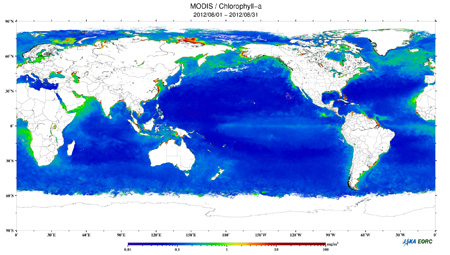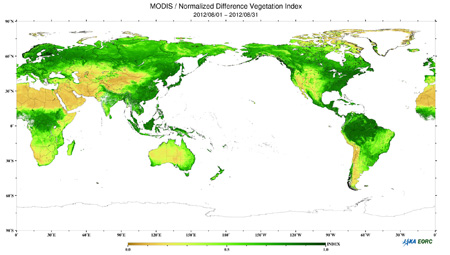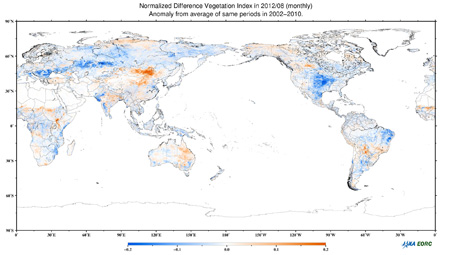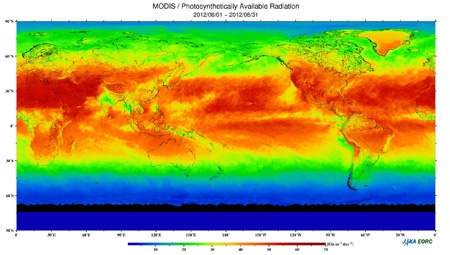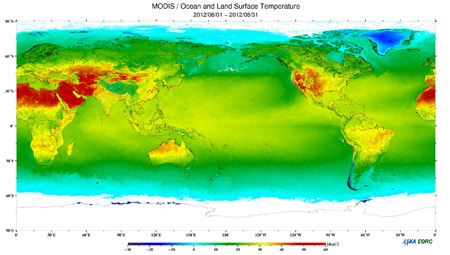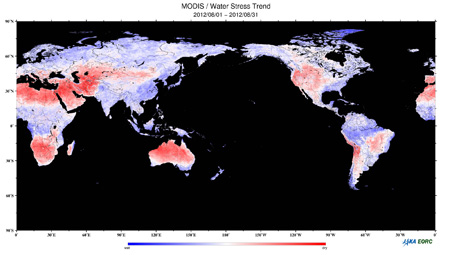Seen from Space 2014
Climate Change and Carbon Cycle
- Vegetation as the Moderator of Greenhouse Effect -
|
Atmospheric carbon dioxide is the greenhouse gas that most significantly influences global warming, according to fossil-fuel consumption associated with daily life and industry, in addition to changes in land use and land cover resulting from deforestation. Atmospheric concentration of carbon dioxide has been increasing since 1750, in which pre-Industrial Revolution levels were approximately 280 ppm in 1750 (Ref. 1). The Japan Meteorological Agency recorded carbon dioxide levels at three domestic measurement points: Ryori in Iwate, Minami-torishima in Tokyo, and Yonakuni-jima in Okinawa. The data measured at Ryori, which recorded the monthly mean in March and April 2012, was 401.2 ppm and 402.2 ppm, respectively, and exceeded 400 ppm as the highest levels documented since 1987 (Ref. 2).
Two ecosystems on the Earth’s surface, the ocean and land, play important roles in the global carbon cycle. The oceanic phytoplankton concentration distribution map (Fig. 1) is a critical source of data for estimating primary carbon production in the ocean. Generally, the concentration is low in the open water and high in coastal zones, in which there are suspended solids in water and aeolian dust-borne yellow sand, clouds, and atmospheric aerosols. Research on atmospheric correction and in-water algorithm improvement 1) (Ref. 5) have been conducted by using former satellites including the Ocean Color Temperature Scanner (OCTS) onboard the Advanced Earth Observing Satellite (ADEOS) and the Global Imager (GLI) onboard Advanced Earth Observing Satellite 2 (ADEOS-II) in Japan. Further, research and development is ongoing through the exploration of intermediate algorithms obtained from Moderate-resolution Imaging Spectroradiometer (MODIS) data in the next phase of satellite data processing and analysis technology. Thus, because of its vulnerability to both direct and indirect influences of human activity and climate change, the terrestrial ecosystem faces significant challenges from the degradation of its carbon fixation ability. The terrestrial ecosystem encompasses grasslands, wetlands, forests, and agro-ecosystems. In the carbon cycle process, carbon fixation occurs through net primary production (NPP) in plants after absorption of carbon dioxide through photosynthesis, which is estimated from the direct measurement of plant growth. NPP is usually defined as the total amount of primary production in one year and is the difference (NPP = GPP - R) between gross primary production (GPP) and respiration (R; Ref. 6, 7). Furthermore, through the measurement of the physiological characteristics of plants; such as the rates of photosynthesis, respiration, and soil respiration; and related environmental conditions; such as changes in temperature and moisture levels as a consequence of their association with the carbon cycle; a knowledge database of NPP estimation models of various ecosystems according to location and plant species has been constructed.
As shown in the upper image of Fig. 2, the vegetation cover index, as indicated by the color bar at the bottom of the map, shows that the area of the largest tropical rainfall forest in the Amazon River Basin of South America and the tropical rainfall forests in central Africa and southeast Asia nearly reach the highest value of 1.0, which is represented on the map by the deep green color. In these forest areas, vegetation is highly dense and active as carbon sinks that fix a substantial amount of carbon. In the index deviation map for August 2012 shown in the lower image of the figure, the red color shows a higher index value of 0.2 compared with the nine-year mean value, and the blue color shows a lower value of -0.2. This map indicates that the blue area representing the central region of the United States, where vegetation activities and densities are lower than normal, suffered the apparent effects of a drought in summer 2012.
The PAR map shown in Fig. 3 indicates a comparatively weak area in the north Amazon River basin and, conversely, a strong area in the south, which appears to be caused by differences in cloud cover.
The land-surface temperature map obtained during August 2012 (Fig. 4, upper image) shows wide areas of high temperature in the Sahara Desert in North Africa, the Arabian Peninsula, the plateaus of Iran, and central Asia, in addition to a relatively high-temperature area in the Midwestern United States. WSTs observed during the same period show a widespread dry area in the western United States. Vegetation activity and distribution coverage data, in addition to environmental factors, are processed and analyzed with medium-resolution (250~1,000 m) and frequent observation data obtained by MODIS sensors onboard Aqua and Terra satellites through the process of cloud-free, color-composite image processing. The processed data can also produce quantitative and visualized information of seasonal and annual changes in vegetative carbon fixation, which can be useful for developing methods to combat global warming (Ref. 8, 9). By improving the accuracy and quality of Earth observation data and environmental information obtained by the Second-Generation Global Imager (SGLI) onboard the Global Change Observation Mission-Climate (GCOM-C), two enhancements are expected to be realized: (1) attaining a high level of climate change prediction and (2) rapid acquisition of observation results from global space agencies. Reference literature1) Teruyuki Nakajima, Hiroshi Murakami, Masahiro Hori, Takashi Y. Nakajima, Hirokazu Yamamoto, Joji Ishizaka, Ryutaro Tateishi, Teruo Aoki, Tamio Takamura, Makoto Kuji, Nguyen Dinh Duong, Akiko Ono, Satoru Fukuda and Kanako Muramatsu: Overview and science highlights of the Advanced Earth Observing Satellite 2 (ADEOS-II)/Global Imager (GLI) project, J. Rem. Sens. Soc. Japan, Vol. 29, No. 1, pp. 11–28, 2009. Reference sitesExplanation of the Images:
SourceRelated Sites
|
